GPU Pinning
Use this feature to distribute Intel GPU devices between MPI ranks.
To enable the GPU Pinning, set I_MPI_OFFLOAD_PIN=1. You can also enable all GPU features and optimizations with I_MPI_OFFLOAD=1.
This feature requires the Level-Zero* library to be installed on the nodes.
Default Settings
I_MPI_OFFLOAD_CELL=tile
I_MPI_OFFLOAD_DOMAIN_SIZE=-1
I_MPI_OFFLOAD_DEVICES=all
By default, all available resources are distributed between MPI ranks as equally as possible given the position of the ranks; that is, the distribution of resources takes into account on which NUMA node the rank and the resource are located. Ideally, the rank will have resources only on the same NUMA node on which the rank is located.
When the GPU Pinning is applied, only pinned devices are available for the rank. It means, other devices are hidden for the rank and cannot be used or discovered. For more details, the Level-Zero* Core Programming Guide.
Starting with I_MPI_DEBUG=3, Intel(R) MPI prints the GPU topology with the number of detected devices (GPUs) and sub-devices (stacks or tiles).
Examples
The examples below represent a machine configuration with two NUMA nodes and two GPUs with two stacks (tiles).
Figure 1. Four MPI Ranks
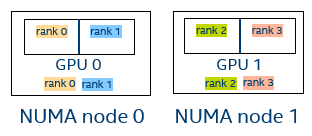
Debug output I_MPI_DEBUG=3:
[0] MPI startup(): ===== GPU pinning on host1 =====
[0] MPI startup(): Rank Pin stack (tile)
[0] MPI startup(): 0 {0}
[0] MPI startup(): 1 {1}
[0] MPI startup(): 2 {2}
[0] MPI startup(): 3 {3}
Figure 2. Three MPI Ranks
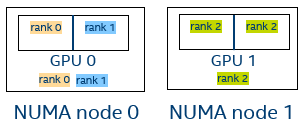
Debug output I_MPI_DEBUG=3:
[0] MPI startup(): ===== GPU pinning on host1 =====
[0] MPI startup(): Rank Pin stack (tile)
[0] MPI startup(): 0 {0}
[0] MPI startup(): 1 {1}
[0] MPI startup(): 2 {2,3}
I_MPI_OFFLOAD_PIN
Control whether GPU pinning is enabled.
Syntax
I_MPI_OFFLOAD_PIN=<value>
Arguments
| Value | Description |
|---|---|
| <0> | Disabled. |
| <l> | Enabled. |
Description
By default, GPU pinning is disabled. To enable, set I_MPI_OFFLOAD_PIN=1 or I_MPI_OFFLOAD=1.
I_MPI_OFFLOAD_TOPOLIB
Set the interface for GPU topology recognition.
Syntax
I_MPI_OFFLOAD_TOPOLIB=<arg>
Arguments
<arg> is a string parameter
| Value | Description |
|---|---|
| level_zero | Use Level-Zero library for GPU topology recognition. |
| none | Disable GPU recognition and GPU pinning. |
Description
Set this environment variable to define the interface for GPU topology recognition.
I_MPI_OFFLOAD_CELL
Set this variable to define the base unit: tile (stack, sub-device) or device (GPU).
Syntax
I_MPI_OFFLOAD_CELL=<cell>
Arguments
| Value | Description |
|---|---|
| <cell> | Specify the base unit. |
| tile | One tile (stack, sub-device). This is the default value. |
| device | Whole device (GPU) with all sub-devices. |
Description
Set this variable to define the base unit. This variable may affect other GPU pinning variables.
Example
Figure 3. Four MPI ranks, I_MPI_OFFLOAD_CELL=device
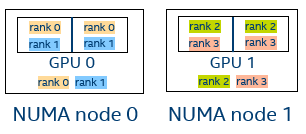
I_MPI_OFFLOAD_DOMAIN_SIZE
Control the number of base units per MPI rank.
Syntax
I_MPI_OFFLOAD_DOMAIN_SIZE=<value>
Arguments
<value> is an integer number.
| Value | Description |
|---|---|
| -1 | Auto. Each MPI rank may have a different domain size to use all available resources. This is the default value. |
| > 0 | Custom domain size. |
Description
Set this variable to define how many base units will be pinned to the MPI rank. I_MPI_OFFLOAD_CELL variable defines the base unit: stack (tile) or device.
Examples
Figure 4. Three MPI ranks, I_MPI_OFFLOAD_DOMAIN_SIZE=1
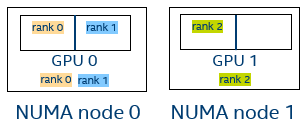
I_MPI_OFFLOAD_DEVICES
Define a list of available devices.
Syntax
I_MPI_OFFLOAD_DEVICES=<devicelist>
Arguments
<devicelist> is a comma-separated list of available devices.
| Value | Description |
|---|---|
| all | All devices are available. This is the default value. |
| <l> | Device with logical number <l>. |
| <l>-<m> | Range of devices with logical numbers from <l> to <m>. |
| <k>,<l>-<> | Device <k> and devices from <l> to <m>. |
Description
Set this variable to define the available devices. This variable also gives you the ability to exclude devices.
Example
Figure 5. Four MPI ranks, I_MPI_OFFLOAD_DEVICES=0
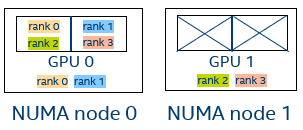
I_MPI_OFFLOAD_CELL_LIST
Define a list of base units to pin for each MPI rank.
Syntax
I_MPI_OFFLOAD_DEVICE_LIST=<base_units_list>
Arguments
<base_units_list> is a comma-separated list of base units. The process with the i-th rank is pinned to the i-th base unit in the list.
| Value | Description |
|---|---|
| <l> | Base unit with logical number <l>. |
| <l>-<m> | Range of base units with logical numbers from <l> to <m>. |
| <k>,<l>-<m> | Base unit <k> and base units from <l> to <m>. |
Description
Set this variable to define the list of base units to pin for each MPI rank. The process with the i-th rank is pinned to the i-th base unit in the list.
- I_MPI_OFFLOAD_CELL variable defines the base unit: stack (tile) or device.
- I_MPI_OFFLOAD_DEVICE_LIST variable has less priority than the I_MPI_OFFLOAD_DOMAIN variable.
Example
Figure 6. Four MPI ranks, I_MPI_OFFLOAD_DEVICE_LIST=3,2,0,1
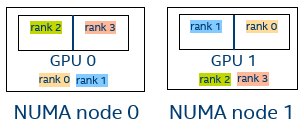
I_MPI_OFFLOAD_DOMAIN
Define domains through the comma separated list of hexadecimal numbers for each MPI rank.
Syntax
I_MPI_OFFLOAD_DOMAIN=<masklist>
Arguments
<masklist> is a comma-separated list of hexadecimal numbers.
| Value | Description |
|---|---|
| [m1,...,mn ] | For <masklist>, each mi is a hexadecimal bit mask defining an individual domain. |
The following rule is used: the i-th base unit is included into the domain if the corresponding bit in mi value is set to 1.
Description
Set this variable to define the list of hexadecimal bit masks. For the i-th bit mask, if the j-th bit set to 1, then the j-th base unit will be pinned to the i-th MPI rank.
I_MPI_OFFLOAD_CELL variable defines the base unit: stack (tile) or device.
I_MPI_OFFLOAD_DOMAIN variable has higher priority than the I_MPI_OFFLOAD_DEVICE_LIST.
Example
Figure 7. Four MPI ranks, I_MPI_OFFLOAD_DOMAIN=[B,2,5,C]. Parsed bit masks: [1101,0100,1010,0011]
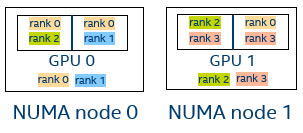
I_MPI_OFFLOAD_PRINT_TOPOLOGY
Print GPU pinning and GPU topology regardless of the the I_MPI_DEBUG level.
Syntax
I_MPI_OFFLOAD_PRINT_TOPOLOGY=<value>
Arguments
| Value | Description |
|---|---|
| 0 | GPU pinning and GPU topology printing depends on I_MPI_DEBUG level:
|
| 1 | Print GPU pinning and GPU topology from all hosts. |
Description
Set this environment variable to enable GPU pinning and GPU topology printing regardless of the I_MPI_DEBUG level.